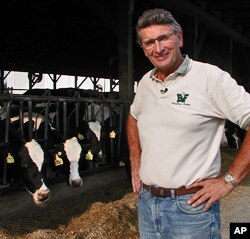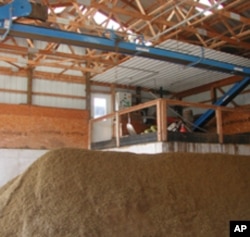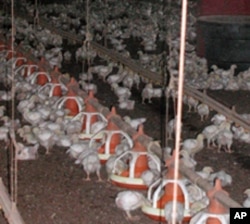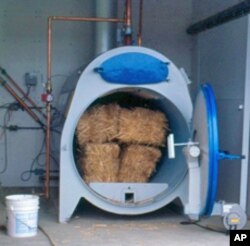Pennsylvania is among the nation's top agricultural states. Luke Brubaker calls it the, "garden spot of the world" for the dairy business. Brubaker manages 700 dairy cows and 48,000 chickens.
He grows corn and soybeans to feed the animals. And he needs clean, fresh water to keep his cows healthy. So he's put grass buffers between fields, installed fencing to keep cows out of streams and roofs over the barns to capture rainwater so it doesn't mix with animal waste. These best management practices prevent field erosion and filter pollutants before they seep into the groundwater.
"Green" dairy farmers turn cow manure into methane power
Brubaker has also installed a computer-driven digester, a high tech machine that takes methane from cow manure and converts it into electricity. "We're making enough electricity on our farm to power 150 to 200 homes all the time," he says. And, he adds, "We're selling that as renewable energy back to the power company." The dry solids separated in the process are sterilized and used as cow bedding in the barns. "It's basically pathogen-free, which for bedding animals is as good as or better than shavings and saw dust" Brubaker says.
Poultry farmers face scrutiny over waste disposal
Southeast from Brubaker's farm is the Delmarva Peninsula, a large coastal land formation that's shared by three states, Delaware, Maryland and Virginia. Poultry is Delmarva's top industry generating 1.6 billion dollars a year, even more than tourism. A few large companies contract with nearly 2,000 growers to raise 600 million birds. These farmers are responsible for 1.1 billion tons of chicken manure from their operations.
It's here Virgil Shockley cycles 75,000 chickens through his four chicken houses each year. Like Brubaker he uses the manure to fertilize his corn and soybean crops, but has more than he needs. He's required by the state to file a nutrient management to control the waste. "They can come on to the farm [and] take a look at what you're doing. So there is a check and balance, if you will, of what is actually going on out there," Shockley says.
An uneven patchwork of voluntary measures, state and federal incentive programs and laws
In 2008 the Environmental Protection Agency's Action Plan for the Chesapeake Bay called on agriculture to come up with two-thirds of the nutrient reductions needed to restore the Bay. While Shockley employs best practices, from grass buffers and no-till planting to waste ponds, cleanup efforts differ widely across the watershed. The result is an uneven patchwork of voluntary measures, state and federal incentive programs and laws.
The good news, says Russell Brinsfield, director of the Agro-Ecology Center on Maryland's eastern shore, is that pollution from agricultural is not getting any worse. He says, "Without some federal oversight, some federal teeth, I don't think that we're ever going to get the states to be serious about Bay cleanup."
Federal regulators get ready to back new rules with enforcement
The Environmental Protection Agency's Lisa Jackson is hopeful that with Obama's Presidential order the Chesapeake Bay can reverse the 25 year course of watershed decline. She says the draft plan released in September is a good start. "We have increased use of our current regulatory authorities," Jackson says.
She is pushing for pollution limits for each state. "We want to see a plan that we can evaluate that shows how you are going to meet the diet that you have been put on." Jackson says the federal government is prepared to impose, "stiff penalties on states that don't stick to that diet and fail to achieve the nutrient reduction goal set for each state. "If we don't think that you're doing the job, we do have the ability to stop you from issuing permits. We can take away federal funding. We can take our own enforcement actions," Jackson stresses.
EPA is working with the United States Department of Agriculture to give farmers technical and financial help to put their best practices to work.
In other words, Jackson says, "What we are saying is, please use this time because most assuredly we are also gearing up to put new regulations in place. We would love nothing more than to have the regulations come in place in a few years and really there would be nobody to regulate because people have seen this coming and have gotten the help they need"
In his executive order, President Obama called for, "bold, dramatic action," to save the Chesapeake Bay. EPA administrator Lisa Jackson says, if the administration responds with less, the cleanup could be in jeopardy.










